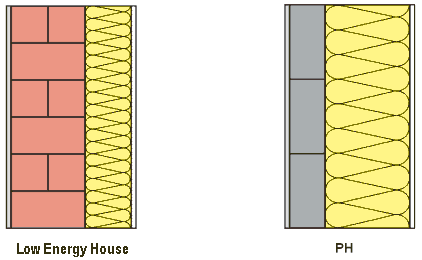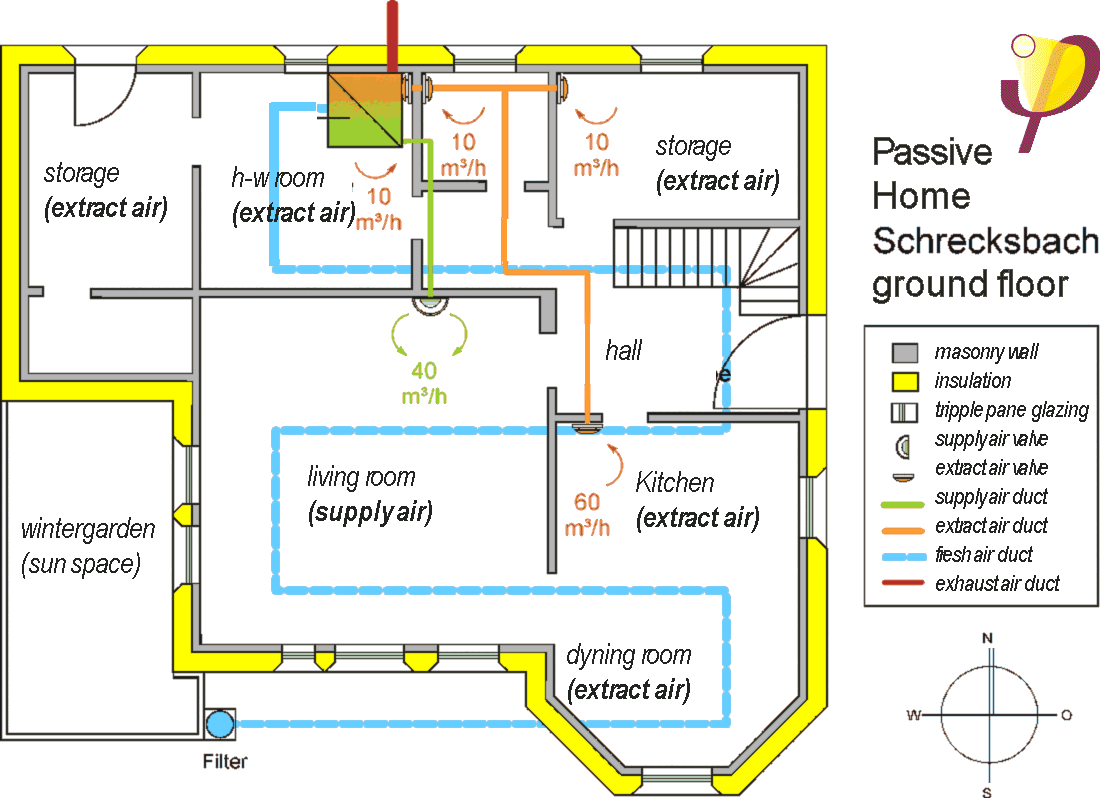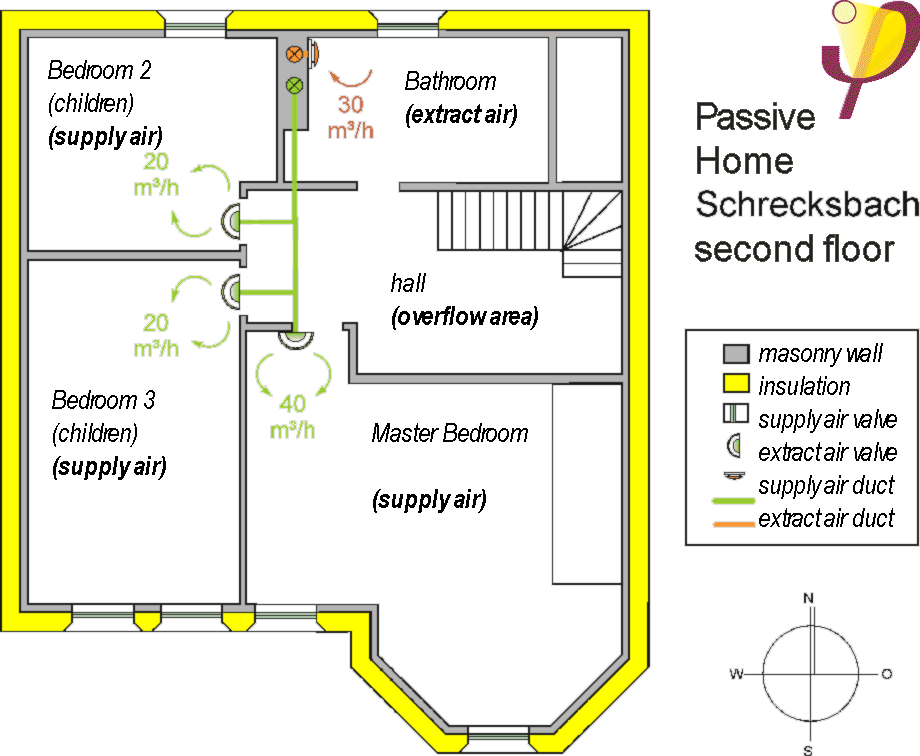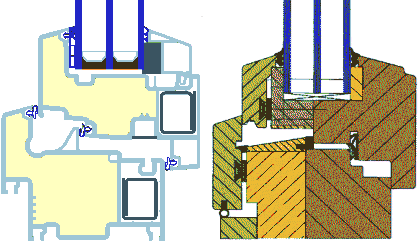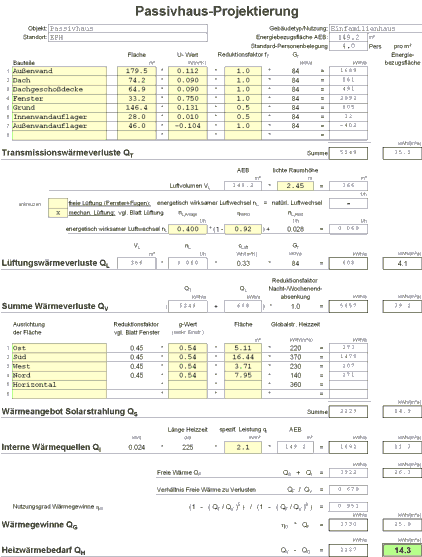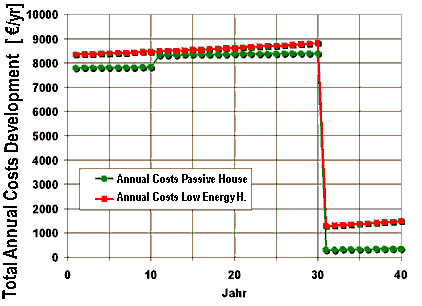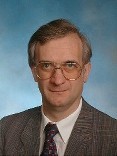| |
Is
it profitable to build a |
|
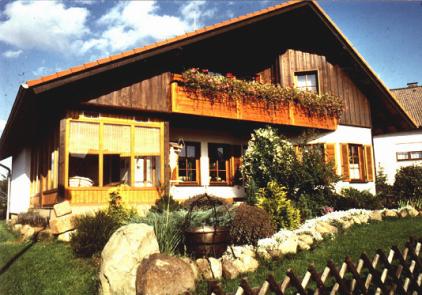
Fig.1: The single family house in Schrecksbach / Germany designed by Manfred Such in 1987 as the first German low-energy building in massive construction (brickwork and concrete floors) - which at the time was very innovative. Today its thermal protection is still somewhat better than required by energy efficiency regulation in Germany (EnEV). We examined how expensive it would be to build this house today as Passive House. For this comparison, the house is first calculated without ventilation system. For this case, the heating requirement is 83 kWh/(m²a)(living area) or 59 kWh/(m²a) (EnEV utilized area calculation value AN). Each year, 1330 litres of heating oil are used for heating.
Fig.
2: The most important step from the "EnEV"
house to the Passive House: The superior thermal insulation.
2) Note: A frequent "trick" with calculating energy usage per unit area (e.g. kWh/m2a) is to change the plans so that a different living or floor area is developed . Since this value can be set to be high or low, the end result becomes an inaccurate way of determing true energy usage. The cleanest method to keep the reference areas alike. That is what we have done here,in truth even increased the surface area somewhat; without taking into account however.
More
on the next Passive House conference: |
| Looking on the internet, one will find many different oppinions. Some state that Passive Houses would never pay-off, while others promise that you can make over "200,000 Euro" profit with a single family Passive House. In short, both statements are wrong. Under the present economic conditions in Germany and Austria Passive Houses pay-off, if they are competently planned and built. Getting rich overnight should not be expected; but investment in the Passive House is more secure than the alternatives. Those wanting "fast money" should try elsewhere (... of course the chances to lose much money are then naturally greater as well). An example analysis of a single family house The house in the left column performs much better than a typical new German single family house with 149 m² floor space. It is not a Passive House - it could easily be built as a passive house though. In order to do this, the following details would have to be improved:
The measures were taken to be suitable within typical Central European climate. In Northern and Eastern Europe the insulation should be even better; in Western Europe less insulation will be needed. In a hot climate the measures are somewhat different, there will be further information about Passive Houses in hot climates published at this website later. To a large extent thermal bridge-free details already existed in the house. Apart from increasing the insulation levels and installing the windows outside before the brick-work no changes are necessary. In place of the timber beam structure used as the second floor in the original building, the Passive House uses a concrete floor which has a substantially smaller structure height, and is more economical. Using this floor system, it is possible to gain usable height on the interior while maintaining the same exterior dimensions of the house, despite the somewhat thicker roof. Also the floor space can be increased somewhat (approx.. 1 m²); however, this increased floor area is not included in the computation in order to not complicate the comparison by a change of the reference areas.2) Also we do not consider the cost saving due to the simpler floor construction. All external walls have plaster on the inside, the roof systems keep air tightness foils, which are covered with the interior plaster at all joints to the exterior walls. Previous experiences show that an airtightness of n 50 =0.4h -1 is attainable. There are no extra costs associated with this. In fact it reduces costs because the higher airtightness protects against building damage - the repair of which is multiples more expensive than the one time investment into a high-quality airtight shell. In addition the improved health for the occupants of the dwelling is not taken into account.
Using straightforward detail improvements described above it is possible to meet the Passive House level of energy consumption. On solution will be, that the existing heating system (boiler in a store room) could be maintained. However it would go even more economical to replace it and the ventilator with a compact unit (already drawn in in the h-w-area). This would eliminate the oil tank, the fire-place and the boiler. The heat distribution piping and radiators can be eliminated - the compact unit can supply the heat directly to the supply air; only in the bathroom on the second floor there must be an extra heating element, this in order to be able to quickly increase the temperature in the bathroom when desired. What does it cost? The improved building components require the installation of additional insulation, better windows (triple pane with two low-e coatings), insulated window installation and a heat recovery ventilator and its associated ductwork:
In order to remain on the safe side, we will round this up to 15,000 €. In any case, a Passive House single family home can be created for this amount which is about an 8% increase in construction costs compared to the German average. Financing It We asume that the house is financed by a mortgage. In this case, the interest rate in Germany is 4.7% and with a repayment of capital of 1.6%, that sums up to an annuity of 945 €. If a Passive House is built, the owner can qualify for the German Federal States Bank "Building Ecologically" credit for the "Passivhaus". This loan has a 100% disbursement and only 2.10% interest (as of the end of April 2006). Each unit qualifies for 50,000 €, in this case a single family house. Savings from the reduced interest rate amounts to approximately 880 € annually! Thus the additional expenses to make this house a Passive House are nearly offset by the savings in interest. How it looks in later years is treated further down. It gets even better: Instead of using approximately 13,300 kWh fuel oil or natural gas, the Passive House needs only approx.. 2290 kWh fuel for heating and 350 kWh electicity for the ventilation system. This saves 715 € per year using today's fuel costs, the electricity for the ventilation system adds approximately 65 € per year in electricity costs.
Does cost alone make it worthwhile? When building a Passive House, expenses are reduced considerably compared to a "normal house", even if energy costs do not increase in the future. Therefore the Passive House is economically attractive - even if the net yield is not enormously high, as is sometimes promised. But the owner of a Passive House benefits from a few more things... Joy of life! With the Passive House, energy consumption is so small that the family will no longer be concerned with energy price increases. The house is practically independent of imported energy. It can even be completely independent through the use of renewable energy. For example: if a heat pump compact mechanical system and an Renewable Electricity Supplier are selected (or by purchasing a share of a wind-generat or wood pellet heating is used or...). But there is more: In a Passive House there are no moldy walls, no drafts, no cold feet. Fresh air is delivered continuously, minimizing indoor air pollution. As Robert Hastings stated at the 8. Passive House Conference: "Passive Houses minimize environmental impacts and maximize the joy of life". Because the consequences of climate change affect everyone, the family can enjoy the decreased environmental impact of the home. The emissions from a Passive House which contribute to global warming are reduced by a factor of 4 compared to "normal" new buildings. These contributions to environmental protection are multipled with each family that decides to build an energy-efficient new building or rennovate an existing building. So far these are individual advantages - however doesn't the community benefit if new jobs are created in the region and import of energy sources from unstable parts of the world is reduced? Consider the passive house depicted above, which costs approximately 14,000 euro more than a usual new building. Of this 14,000 euro, 75% will go to local builders. The remaining 25% goes to purchase materials predominantly of regional origin. That creates jobs - it even "pays off". The community saved the costs of international tensions which need not be discussed here, they can be seen in the newspaper on any given day. This also contributes to the joy of life, because "securing energy resources" does not only cost money. In the Longer Term, only Energy Efficiency Saves Money Above all, it is
the energy conservation which reduces costs in the longer run.
Without it, when the promotional interest credits expire, one
could experience high expenses. It is recommended to use the
incentives for proven energy-efficiency measures, e.g. what
has been specified above, thermal insulation, windows and the
ventilation system. The fact: That these measures save energy
in practice has been proven by measurements (see Passive
house practice results).
Table showing annual predicted ownership costs over 30 years:
Boundary
conditions: Remark
to evtl. Changes with the boundary conditions:
This link leads to basic information about Passive Houses.
(last changed: 6.05.2007 / author Dr. Wolfgang Feist; thanks to David Stecher for proof reading of the 1st edition © Passive House Institute; unchanged copy is permitted, please give reference to this page) |
||||||||||||||||||||||||||||||||||||||||||||||||||||||||||||||||||||||||||||||||||||||||||||||||||||
